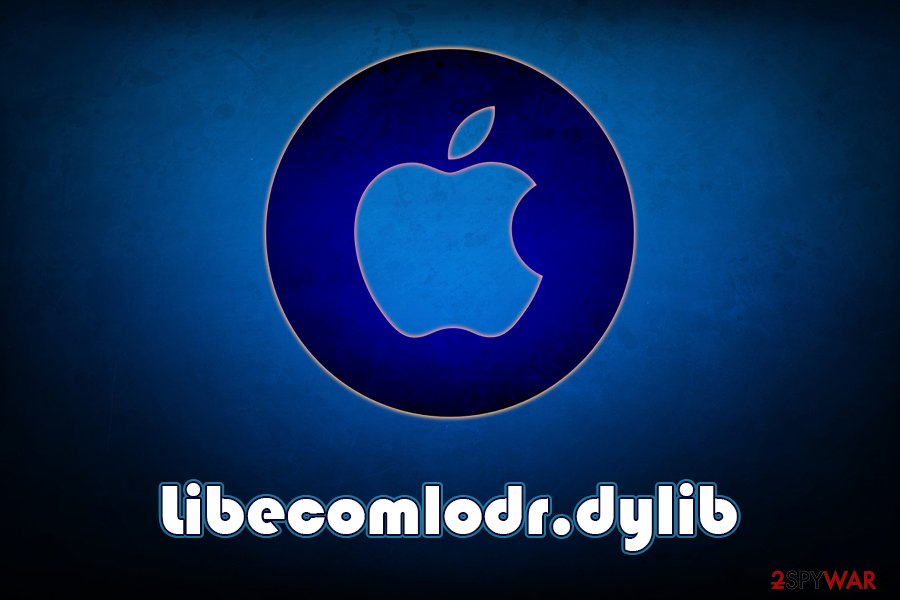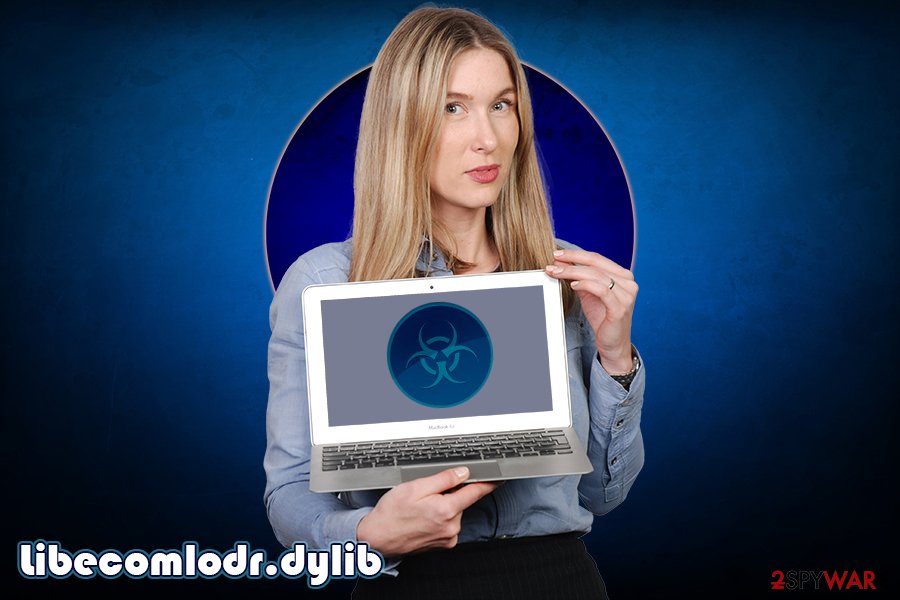Libecomlodr.dylib is a Mac infection that will cause browsing disruptions with ads

Libecomlodr.dylib is a suspicious app for Macs that delivers intrusive advertisements on all web browsers

Libecomlodr.dylib is a suspicious app for Macs that delivers intrusive advertisements on all web browsers
Libecomlodr.dylib is a component of a potentially unwanted applications[1] that are designed exclusively for Mac computers. These suspicious apps usually travel within software bundle packages that users download from third-party sites, although some may get infected after they encounter a fake Adobe Flash Player update prompt. Nevertheless, users rarely install Libecomlodr.dylib app intentionally, and some might not even know that it is the component that has been causing browsing disturbances on the computer.
Once on the system, Libecomlodr.dylib may inject several .plist files, append an extension to Safari, Google Chrome, Mozilla Firefox, or another web browser, and change the homepage/new tab address to something different. In some cases, users may be redirected to legitimate search providers such as Yahoo, although quite often an unreliable and unknown engine is used to deliver search results, which might be filled with sponsored links. Additionally, Libecomlodr.dylib virus might also gather information in the background – an activity which is never obvious to end users.
| Name | Libecomlodr.dylib |
| Type | Mac virus, adware |
| Infiltration | In most cases, users infect their Macs adware or other parasites after they get tricked by Flash player update prompts or during the installation of freeware from third-party sites |
| Dangers | Personal information disclosure to unknown parties (cybercriminals), installation of other PUPs or malware, monetary loss due to encountered scams |
| Affected OS | macOS, Mac OS X |
| Termination | To get rid of Mac infection completely, you should scan the machine with powerful anti-malware software and then reset all the installed browsers so that unwanted activity would not return |
| Further actions | If your system is suffering from slowdowns and lag even after you eliminate potentially unwanted applications, you should employ Reimage Reimage Cleaner or similar tool to free up the computer from junk and other useless files |
Adware is an ever-growing threat to users who choose Apple devices for their daily online time. Over the years, the number of users who choose this platform increased, so the supply of potential victims that could be exploited made it an attractive choice for cybercriminals. And Libecomlodr.dylib is just one of thousands of infections that are lurking online every day.
According to experts, malware development for Macs increased significantly over the course of 2019 – these devices are more likely to be targeted by adware than even Windows computers worldwide.[2] While adware is not considered to be malware, it could cause significant financial losses and put users’ security, as well as privacy at risk. This is why Libecomlodr.dylib removal, among others, is so important.
Users do not usually notice the infiltration of Libecomlodr.dylib adware on their devices due to deceptive distribution tactics, and they instead see the symptoms that the infection is a direct result of. For example, users may experience the following signs of intrusion:
- Unknown extensions installed on the web browser;
- New tab address and homepage set to unknown URL;
- Slowdown of the web browser operations;
- Intrusive pop-ups, deals, banners, offers, coupons, and other commercial content appears on all visited websites;
- Redirects lead to unknown sites that are filled with scams, phishing messages, and other unsafe content.
Besides causing major disruptions when trying to perform usual web browsing activities, Libecomlodr.dylib virus is also set to gather information about users’ web browsing habits. With the help of cookies, web beacons,[3] pixels, and other tracking technologies, the PUP collects data like the IP address, technical information about the device, installed apps, timestamps, visited websites, bookmarks added, links clicked, etc.
This way, Libecomlodr.dylib redirects can bring users to sites that are more relevant to their interests, increasing the chances of them purchasing products or services offered. Unfortunately, The commercial content might be coming from an unsafe advertisement network. For example, renting ad space to cybercriminals that could insert malicious JavaScript into the ad that would be launched automatically as soon as user visits the site, resulting in malware infections.
Therefore, to remove Libecomlodr.dylib redirects and ads, you will have to locate a potentially unwanted program on your system and eliminate it for good. In most cases, security applications that have PUP detection feature can eliminate all the existing threats on Mac machines, although sometimes some components have to be cleaned manually. Also, experts[4] recommend resetting the installed web browsers and scanning the machine with Reimage Reimage Cleaner for best results.

Libecomlodr.dylib is an adware application that is usually installed along freeware

Libecomlodr.dylib is an adware application that is usually installed along freeware
Avoid unofficial download sources and never download “updates” for Flash
Mac users are usually tricked by fake Flash updates – they are asked to update the plugin in order to access the contents of the website. However, all of these prompts that can be seen within the web browser are fake – their main goal is to make you install adware, scamware, or malware on your computer.
Users associate Adobe Flash with something legitimate and useful – this multimedia platform was dominant for many years. However, the technology has long been replaced by a far less vulnerable and secure one – HTML 5. Therefore, none of the users, especially those that use Google Chrome, are in need of Adobe Flash (even a legitimate version). For that reason, you should simply ignore prompts that ask you to update this plugin – they are all scams.
Another technique commonly used to distribute adware is called software bundling. It involves a scheme where several applications are packed into a single installer and are offered to users during installation. While bundling software is common and legitimate practice, many developers and software distribution owners abuse this trait and do not disclose these optional components adequately. In other words, they do everything to make sure that as many users as possible would miss the optional installs, to receive the monetary gain from each.
To protect yourself from this deceptive practice, follow these simple tips:
- If possible, download applications from trustworthy/official sources like App Store or Google Web Store;
- Before installing an unknown app, check online reviews – they often hint about suspicious behavior;
- When prompted, always select Advanced or Custom settings instead of Recommended/Quick ones;
- Watch out for tricks employed to deceive: pre-selected boxes, fine print text, misleading offers, misplaced buttons, etc.
- Protect your system with a sophisticated anti-malware solution capable of warning you about PUAs.
Get rid of Libecomlodr.dylib ads and other unwanted activity on your device
Libecomlodr.dylib removal might sometimes require a bit more actions rather than dragging the unwanted app to Trash. Unfortunately, but many adware apps often leave traces and files scattered in various macOS folders. To get rid of them manually, you will have to check the following locations:
Library/LaunchAgents
Library/Application Support
Library/LaunchDaemons
Additionally, you might want to look for suspicious profiles that might have been established by the Libecomlodr.dylib virus. To access the list of profiles, go to System Preferences > Users and delete the account you don’t recognize.
Nevertheless, if you want to save some time or you do not know what exactly should be deleted, you should rely on anti-malware software to remove Libecomlodr.dylib from your system automatically. As the last step, you should also reset all the installed browsers, as adware may have added unwanted extensions or changed some settings without your permission – you will find the instructions below.
You may remove virus damage with a help of Reimage Reimage Cleaner . SpyHunter 5Combo Cleaner and Malwarebytes are recommended to detect potentially unwanted programs and viruses with all their files and registry entries that are related to them.
This entry was posted on 2020-03-11 at 10:29 and is filed under Mac Viruses, Viruses.

